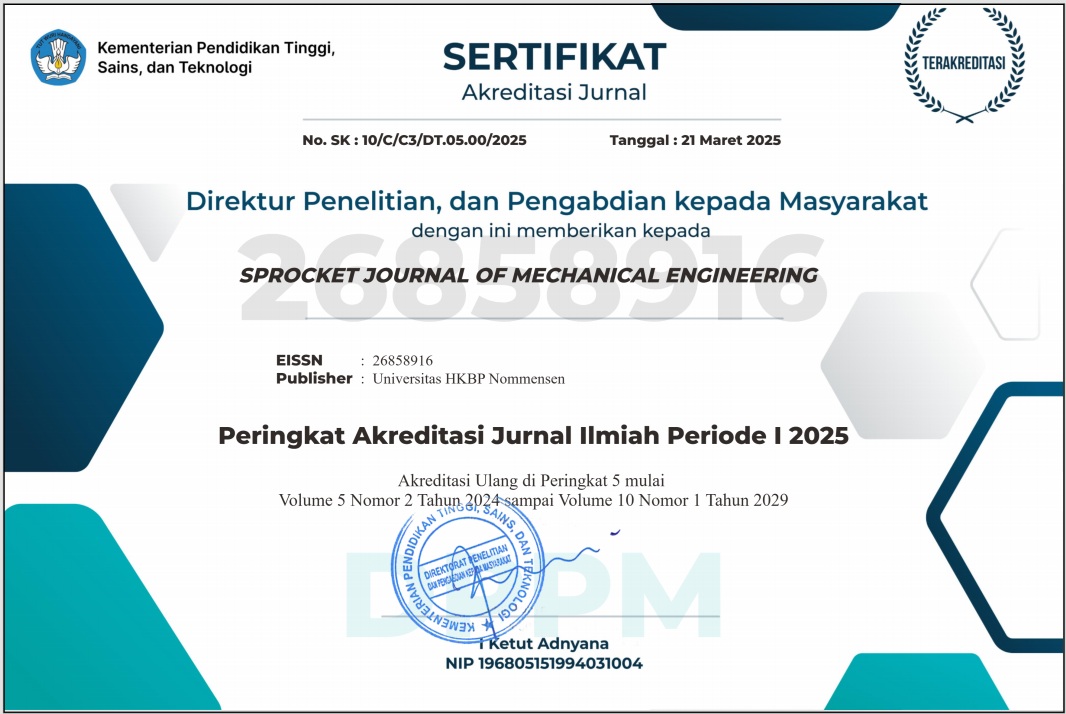Pengaruh Media, Temperatur Dan Waktu Perlakuan Annealing Pada Spesimen Standar ASTM D638 Type IV Menggunakan Filamen ST PLA
Abstract
Fused Deposition Modeling (FDM) is a technique of 3D Printing machines that is popularly used to print products. The printed product certainly has the ideal tensile strength characteristics if it has a precise size and good shape according to the standard. One of the materials that can be processed in a 3D printing machine is ST PLA. Research in terms of tensile testing has been carried out on PLA/ABS materials. However, tensile testing with annealing process using ST PLA filament is still very rarely done. From these problems, it is necessary to research to obtain optimal process parameters on 3D printing machines, to obtain the highest tensile strength from the annealing process using ST PLA material. This research was conducted using a 3D printer DIY Prusa model with a printing area of XYZ, 300 mm x 300 mm x 350 mm. The material used is ST PLA filament with a diameter of 1.75 mm in green. The process parameters in this research are layer thickness, nozzle temperature and flow rate. For annealing media use beach sand, coffee and wheat. The shape of the test specimen follows the ASTM D638 type IV standard. As for the design of the process parameters using the Taguchi L9 method (33). The process parameter values that produce the highest tensile strength without annealing are layer thickness 0.3 mm, nozzle temperature 205oC, and flow rate 100%. The annealing process parameters that produce the highest tensile strength are annealing time of 15 minutes, oven temperature of 110oC, for annealing media using coffee.
References
[2]. Andriyansyah, Deni, Herianto and Purfaji. (2018) , Optimasi Parameter Proses 3D Printing Terhadap Kekuatan Tarik Filamen Polylactic Acid Menggunakan Metode Taguchi. 2018, Seminar Naisonal Pendidikan Teknik Otomotif , pp. 61-68.
[3]. Butt, Javaid and Bhaskar, Raghunath. (2020) , Investigating the Effects of Annealing on the Mechanical Properties of FFF-Printed Thermoplastics, Manufacturing and Materials Processing, pp. 2-20.
[4]. Geng, Peng, et al. (2018) , Effects of Thermal Processing and Heat Treatment Condition on 3D Printing PPS Properties.Polymers, pp. 2-12.
[5]. Halawa, Erniwati. (2013) , Pengarug Annealing Terhadap Sifat Fisis Dan Mekanik Polietelen -Grafting -Maleat Anhidride (PE-g-MAH). Eienstein, pp. 8-14.
[6. Kholil, A., Aufi, F. and Syaefudin, E.A. 2020, Pengaruh Layer Thickness Dan Orientasi 3D Printing Terhadap Uji Tarik Material ABS . NCIET , pp. 219-226.
[7]. Slavkovic, Vukasin, et al. (2017) , Pengaruh Arah Pengumuman dan Pencetakan Pada Sifat Mekanis Polimer Memori Bentuk PLA yang Dihasilkan oleh Pemodelan Deposisi Fused., Serbian society of mechanics mountain tara, pp. 1-8.
[8]. Srithep, Yotta, Nealey, Paul and Sheng Trung, Lih. (2012) , Effects of Annealing Time and Temperature on The Crystallinity and Heat Resistance Behavoir Of injection-Molded Poly(lactic-Acid) . Polymer Engineering and Science , pp. 1-9.
[9]. Suzen, Z.S., Hasdiansah and Yulianto. (2020) , Pengaruh Tipe Infill dan Temperatur Nozzle Terhadap Kekuatan Tarik Produk 3D Printing Filamen PLA+ Esun. Jurnal Teknologi Manufaktur , pp. 74-80.
[10]. yu, long, et al. (2008) , Effect of Annealing and Orientation on Microstructures and mechanical Properties of Polylactic Acid. POLYMER ENGINEERING AND SCIENCE , pp. 635-641.

This work is licensed under a Creative Commons Attribution 4.0 International License.
Penulis yang menerbitkan dengan SPROCKET JOURNAL OF MECHANICAL ENGINEERING menyetujui ketentuan berikut :
- Penulis memegang hak cipta dan memberikan jurnal hak penerbitan pertama dengan karya yang dilisensikan secara bersamaan di bawah Lisensi Internasional Creative Commons Atribusi 4.0 . yang memungkinkan orang lain untuk berbagi karya tersebut dengan pengakuan atas kepengarangan karya dan penerbitan awal dalam jurnal ini.
- Penulis dapat membuat pengaturan kontraktual tambahan yang terpisah untuk distribusi non-eksklusif atas versi jurnal yang diterbitkan dari suatu karya (misalnya, mempostingnya ke repositori institusional atau menerbitkannya dalam sebuah buku), dengan pengakuan atas penerbitan awalnya di jurnal ini.
- Penulis diizinkan dan didorong untuk mengunggah karya mereka secara daring (misalnya, di repositori institusi atau di situs web mereka) sebelum dan selama proses penyerahan, karena hal ini dapat mengarah pada pertukaran yang produktif, serta kutipan yang lebih awal dan lebih banyak dari karya yang diterbitkan (Lihat Pengaruh Akses Terbuka ).






.png)
.png)

